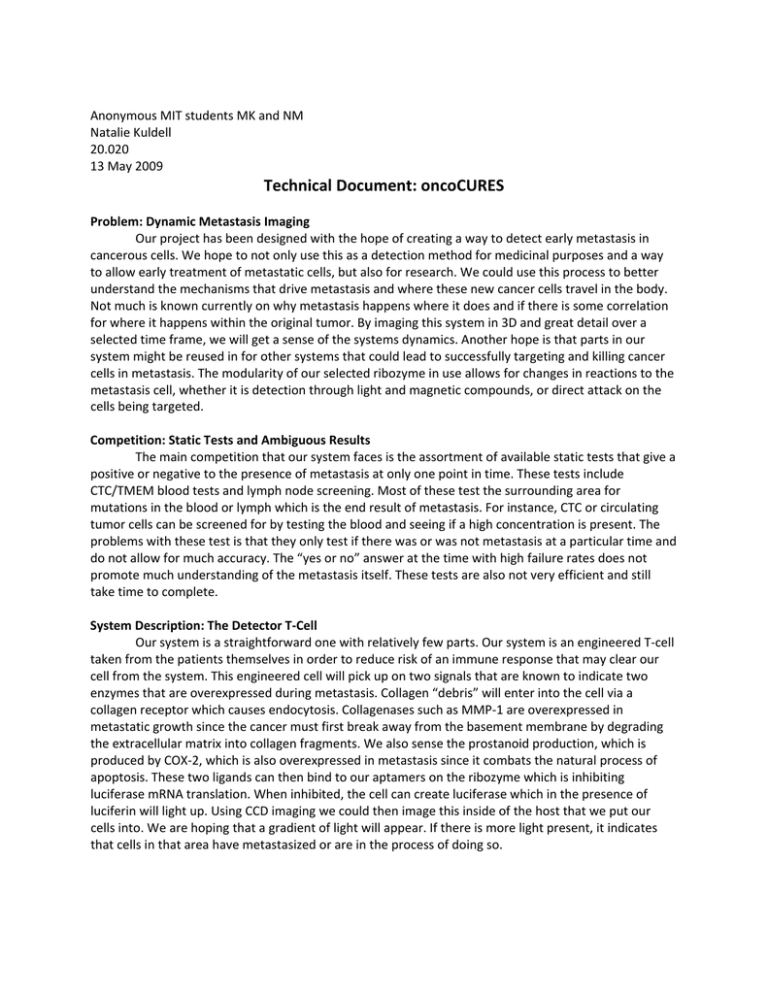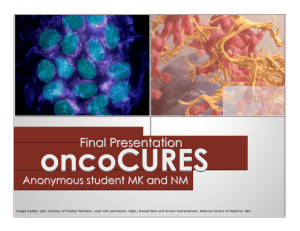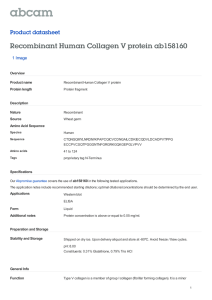Technical Document: oncoCURES
advertisement

Anonymous MIT students MK and NM Natalie Kuldell 20.020 13 May 2009 Technical Document: oncoCURES Problem: Dynamic Metastasis Imaging Our project has been designed with the hope of creating a way to detect early metastasis in cancerous cells. We hope to not only use this as a detection method for medicinal purposes and a way to allow early treatment of metastatic cells, but also for research. We could use this process to better understand the mechanisms that drive metastasis and where these new cancer cells travel in the body. Not much is known currently on why metastasis happens where it does and if there is some correlation for where it happens within the original tumor. By imaging this system in 3D and great detail over a selected time frame, we will get a sense of the systems dynamics. Another hope is that parts in our system might be reused in for other systems that could lead to successfully targeting and killing cancer cells in metastasis. The modularity of our selected ribozyme in use allows for changes in reactions to the metastasis cell, whether it is detection through light and magnetic compounds, or direct attack on the cells being targeted. Competition: Static Tests and Ambiguous Results The main competition that our system faces is the assortment of available static tests that give a positive or negative to the presence of metastasis at only one point in time. These tests include CTC/TMEM blood tests and lymph node screening. Most of these test the surrounding area for mutations in the blood or lymph which is the end result of metastasis. For instance, CTC or circulating tumor cells can be screened for by testing the blood and seeing if a high concentration is present. The problems with these test is that they only test if there was or was not metastasis at a particular time and do not allow for much accuracy. The “yes or no” answer at the time with high failure rates does not promote much understanding of the metastasis itself. These tests are also not very efficient and still take time to complete. System Description: The Detector T‐Cell Our system is a straightforward one with relatively few parts. Our system is an engineered T‐cell taken from the patients themselves in order to reduce risk of an immune response that may clear our cell from the system. This engineered cell will pick up on two signals that are known to indicate two enzymes that are overexpressed during metastasis. Collagen “debris” will enter into the cell via a collagen receptor which causes endocytosis. Collagenases such as MMP‐1 are overexpressed in metastatic growth since the cancer must first break away from the basement membrane by degrading the extracellular matrix into collagen fragments. We also sense the prostanoid production, which is produced by COX‐2, which is also overexpressed in metastasis since it combats the natural process of apoptosis. These two ligands can then bind to our aptamers on the ribozyme which is inhibiting luciferase mRNA translation. When inhibited, the cell can create luciferase which in the presence of luciferin will light up. Using CCD imaging we could then image this inside of the host that we put our cells into. We are hoping that a gradient of light will appear. If there is more light present, it indicates that cells in that area have metastasized or are in the process of doing so. Impact: Understanding and Research The system itself would have a large impact on imaging metastatic regions in the body. As the current system is now it would not be able to track metastatic cells through the body, but our system can be reengineered easily to accomplish this task. As our system currently is, it is a new revolutionary method to track regions of the serious areas of cancer. Hopefully by detecting this early doctors might be able to fight off serious cancerous growth. If this proves ineffective we can focus on using this system as a laboratory tool. There also may be future developments that could lead to metastatic cell killers which may be an effective treatment to slow metastasis and prolong patients’ lives. Safety: Foreign Bodies and Dosage Amounts Some of the concerns that our system raises include rejection by the host. We hope to avoid this by using the patient’s own hematopoetic stem cells and growing them in media to make helper T‐cells. Ideally the necessary markers will be present on these cells so that the body does not recognize what we are introducing as foreign. We also do not know whether our system will properly leave the body without harming the host and remaining in the body. There is also some question as to what is the appropriate dose of luciferin and the negative effects it may have if it is present in great quantities. With the excessive production and presence of these cells, we hope that we also do not put strain on the human body. Current research shows that as many as 109 cells must be added to be effective. We cannot say without further testing what this may mean for our patients. Security: Delivery and Death‐Programming We also have to address the security issues with this system as well. Our system is meant to survive in the human body long enough to transport and mark a certain region. Under malicious means, these cells can be misused and deliver harmful substances instead. We propose that our system not be available to the public to attempt to remove this risk. Also, it is possible to engineer our T‐cell system to die after its usefulness has run out by disabling key enzymes that are necessary for normal function. One example is the PARG enzyme which breaks down poly‐ADP ribose into smaller chunks for reuse. Without this enzyme, a build up occurs that slows growth and eventually triggers apoptosis. Six Month Work Plan: Specificity and Localization For the first six months, there are many different parts we need to look at and develop. First, creating a collagen receptor that is most effective and specific to MMP‐1 will decrease false positives. We can do that by introducing small mutations into the receptor and measure the efficiency of the collagen debris binding. By repeating this process we will be able to find the DNA sequence that is most efficient at allowing collagen to enter the cells. We would also have to address the issue of endocytosis of the collagen which natural leads to further degradation by the lysosomes. This can be delayed through chemical means, though effectiveness and side effects are unknown. The next step is to develop our aptamers on the sensor domain of the ribozyme. The research that has been done up to now on aptamers have only used small molecules to bind to it. Since the collagen debris that we plan to use is fairly large we must find a way to engineer the aptamer to accept this compound. Further research would involve making sure expression and reactions occur normally in isolated T‐cells in vitro. The final move would be to make clinical in vivo trials possible. Device‐Level System Diagram: COLLAGEN RECEPTOR Timing Diagram: S A Note: here, we have used “S” to stand for protein/enzyme synthesis and “A” to stand for the activation or interaction of the enzyme with the specified substrates. This documents the action and concentration of enzymes and compounds respectively within the engineered T‐cell itself. The collagen receptor and inhibitor or ribozyme are synthesized at the beginning of the T‐cells functional lifetime and remain in place waiting for the necessary activation. Binding to collagen breakdown components from the extracellular reaction of MMP‐1 leads to the activation of the collagen receptor. As it brings the debris into the cell, there is a corresponding spike in the concentration of collagen components. Prostanoids are shown to spike in concentration at this time, though their presence may occur at any time due to its passive diffusion across the cell membrane. The combined spike in prostanoid and debris concentration leads to the eventual “activation” of the inhibitor, though the interactions of the signals with the inhibitor actually disable its cleavage of luciferase mRNA or inhibition of luciferase production. It is clear that the synthesis of luciferase follows and with a necessary dosage of light, luciferase is activated and able to produce light. Parts List: Common Name: Collagen Receptor Scientific Name: Endo 180 Location: Description: http://partsregistry.org /Part:BBa_M12064 Light Producer Luciferase http://partsregistry.org /Part BBa_I712564 GFP GFP http://partsregistry.org /Part BBa_E0240 Inhibitor Hammer‐ head Ribozyme mCMV Promoter h2CMV Promoter SV40 Promoter Region N/A enzyme embedded in plasma membrane, causes receptor‐mediated endocytosis of collagen debris produced by MMP‐1 reactions from extracellular region enzyme that can oxidize the pigment substrate luciferin and produce light within the cell protein that is used as a reporter, gives off a notable green color that shows expression of the nearby enzyme ribozyme used to inhibit the expression of the upstream enzyme by cleavage at the mRNA stage, preventing translation genetic viral promoter that causes moderately strong expression genetic viral promoter that causes the greatest amount of expression gene sequence used in conjunction with other viral promoters to enhance the binding and increase promoter strength Strong http://partsregistry.org Promoter /Part:BBa_I712004 Strongest N/A Promoter N/A Strong Promoter Region Spotlighted Part: The Endo180 Receptor Endo180/uPARAP was used in our system to bring the necessary collagen debris into the cell so that it is available to bind to our ribozyme aptamers. This part was entered into the official Registry of Standard Parts as BBa_M12064 and labeled as human MRC due to its alternative name used in the NCBI database from which the DNA sequence was recovered. Its function is documented as a "trans‐ membrane enzyme that is used to bind collagen and initiate receptor‐mediated endocytosis to bring collagen into the cell and cause degradation of the collagen, important for the turnover of the extracellular matrix." Testing and Debugging: Building the System Up We plan on testing our system in‐vitro to see if it can work in a media rich with prostanoids and collagen fragments. By doing this, we not only see if the collagen receptor works, but also test our ribozyme to see if it is producing luciferase and thus light. We also can insert GFP onto the sequence that codes for each part. Therefore we can see if the part is properly translated and in the location we want it to be in. We can also use freeze‐fracture method that would allow us to freeze the cell, disrupting the hydrophobic interactions, and be able to open the cell and see if our collagen receptor is there. MIT OpenCourseWare http://ocw.mit.edu 20.020 Introduction to Biological Engineering Design Spring 2009 For information about citing these materials or our Terms of Use, visit: http://ocw.mit.edu/terms.





